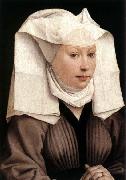Wholesale Oil Painting No Minimum |
|||||||||||
|
|
|||||||||||

|
|||||||||||
|
|
|
||||||||
WEYDEN, Rogier van derNetherlandish Northern Renaissance Painter, ca.1400-1464 major early Flemish master, known also as Roger de la Pasture. He is believed to have studied with Robert Campin. His early works also show the influence of Jan van Eyck. Van Eyck, however, had been a master at objective rendering of detail, whereas Roger in his work portrayed emotions with an assurance that has not been surpassed. His ability to depict piety is reflected in the early masterpiece Descent from the Cross (c.1435; Prado); he depicted with significant restraint the profound grief of the mourners grouped around the tragic figure of Jesus. His composition strongly affected later representations of the theme. Roger became City Painter in Brussels in 1436. He then produced a series of undated altarpieces including the Last Judgment (hospital, Beaune), the Braque Triptych (Louvre), Crucifixion with Donors (Vienna), and Adoration of the Magi (Berlin), which vary in execution from a stress on sumptuous details to a more sculptural rendering of the figures. Roger is believed to have made a pilgrimage to Italy in the holy year 1450. Whether this supposed excursion had any effect on his style is much debated. It has been shown that his Entombment (Uffizi) bears an affinity to the Tuscan treatment of the subject, particularly by Fra Angelico, and that Roger's Virgin and Child with Saints (Frankfurt) has a strong resemblance to the Italian religious art of the day. His style is, however, highly individual. His religious paintings and his portraits are characterized by a straightforward monumentality. The portraits, such as that of a young lady (National Gall. of Art, Washington, D.C.) and of Francesco d'Este (Metropolitan Mus.) exhibit a simple clarity of contour and psychological penetration. Other notable works are his St. Luke Painting the Virgin, of which a version or replica is in the Museum of Fine Arts, Boston, the Crucifixion |
||||||||
|
|
||||||||
Lady Wearing a Gauze Headdress
Lady Wearing a Gauze Headdress Painting ID:: 63849 |
1445 Oil on oak panel, 47 x 32 cm Staatliche Museen, Berlin Leaving aside the portraits of the Duke and Duchess of Burgundy (Philip the Good and Isabella of Portugal), which have been preserved only in copies (by anonymous masters, now in Berlin and Malibu), the only extant panel portrait from the period before about 1450 is the Portrait of a Young Woman. The young woman, with her expansive Flemish winged or horned coif of fine linen, through which the forehead remains visible, fills almost the entire panel. The 'nakedness' of the face and the softness of the features form an attractive contrast to the firm outlines of the stiffly folded linen and the dark background. The sitter's hands with beringed fingers are laid firmly on one another and rest on an invisible sill, support being provided visually by the frame. While in his twenties the artist married Elisabeth Goffaerts, a native of Brussels, and it has been generally assumed that she is the subject of the Berlin portrait. Although there is no real foundation for it, this is not an unreasonable assumption; the open, warmhearted expression seems to preclude an official portrait and to suggest someone close to the artist. It was undoubtedly this impression of intimacy created in this portrait - it occurs nowhere else in the painter's work - which seemed to call for some explanation. To portray the subject looking directly at the viewer was something quite new when this painting was executed; in the Netherlands this technique occurs for the first time in van Eyck's portraits. The resemblance to the portrait of a woman by the Master of Fl?malle (now in the National Gallery, London) is worth noting. The artist has modelled his subject with sympathy and sensitivity, while avoiding contact with the observer.Artist:WEYDEN, Rogier van der Title: Lady Wearing a Gauze Headdress Painted in 1401-1450 , Flemish - - painting : portrait 1445 Oil on oak panel, 47 x 32 cm Staatliche Museen, Berlin Leaving aside the portraits of the Duke and Duchess of Burgundy (Philip the Good and Isabella of Portugal), which have been preserved only in copies (by anonymous masters, now in Berlin and Malibu), the only extant panel portrait from the period before about 1450 is the Portrait of a Young Woman. The young woman, with her expansive Flemish winged or horned coif of fine linen, through which the forehead remains visible, fills almost the entire panel. The 'nakedness' of the face and the softness of the features form an attractive contrast to the firm outlines of the stiffly folded linen and the dark background. The sitter's hands with beringed fingers are laid firmly on one another and rest on an invisible sill, support being provided visually by the frame. While in his twenties the artist married Elisabeth Goffaerts, a native of Brussels, and it has been generally assumed that she is the subject of the Berlin portrait. Although there is no real foundation for it, this is not an unreasonable assumption; the open, warmhearted expression seems to preclude an official portrait and to suggest someone close to the artist. It was undoubtedly this impression of intimacy created in this portrait - it occurs nowhere else in the painter's work - which seemed to call for some explanation. To portray the subject looking directly at the viewer was something quite new when this painting was executed; in the Netherlands this technique occurs for the first time in van Eyck's portraits. The resemblance to the portrait of a woman by the Master of Fl?malle (now in the National Gallery, London) is worth noting. The artist has modelled his subject with sympathy and sensitivity, while avoiding contact with the observer.Artist:WEYDEN, Rogier van der Title: Lady Wearing a Gauze Headdress Painted in 1401-1450 , Flemish - - painting : portrait |
|||||||
|
CONTACT US |

